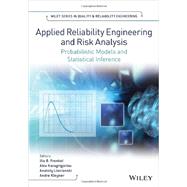With comprehensive coverage of the theoretical and practical issues of both classic and modern topics, it also provides a unique commemoration to the centennial of the birth of Boris Gnedenko, one of the most prominent reliability scientists of the twentieth century.
Key features include:
- expert treatment of probabilistic models and statistical inference from leading scientists, researchers and practitioners in their respective reliability fields
- detailed coverage of multi-state system reliability, maintenance models, statistical inference in reliability, systemability, physics of failures and reliability demonstration
- many examples and engineering case studies to illustrate the theoretical results and their practical applications in industry
Applied Reliability Engineering and Risk Analysis is one of the first works to treat the important areas of degradation analysis, multi-state system reliability, networks and large-scale systems in one comprehensive volume. It is an essential reference for engineers and scientists involved in reliability analysis, applied probability and statistics, reliability engineering and maintenance, logistics, and quality control. It is also a useful resource for graduate students specialising in reliability analysis and applied probability and statistics.
Dedicated to the Centennial of the birth of Boris Gnedenko, renowned Russian mathematician and reliability theorist








